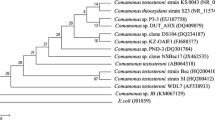Abstract
Phenanthrene-degrading bacteria were isolated from enrichment cultures of soils contaminated with creosote and jet fuel. The isolates from the creosote enrichments were classified by fatty acid methyl ester profiles as Acidovorax delafieldii and Sphingomonas paucimobilis; the bacterium from the jet fuel-contaminated soil was not identified and was designated strain JFD 11. All three isolates used phenanthrene as a sole carbon and energy source, and two of the isolates used fluoranthene as a sole carbon and energy source. Anthracene and fluorene were cometabolized by all three strains, but pyrene was not transformed. Naphthalene inhibited all of the strains, and 28-h cultures of A. delafieldii were inhibited by naphthalene concentrations as low as 5 ppm. Short-term degradation experiments were undertaken with center-well flasks and concentrations of phenanthrene ranging from 1.2 to 12.0 μm. Since initial degradation rates were not a function of phenanthrene concentration, it was inferred that the half-saturation constants were less than the lowest phenanthrene concentration tested.
Similar content being viewed by others
References
Aichinger G, Grady CPL Jr, Tabak HH (1992) Application of respirometric biodegradability testing protocol to slightly soluble organic compounds. Water Environ Res 64:890–900
Al-Bashir B, Hawari J, Samson R, Leduc R (1994) Behavior of nitrogen-substituted naphthalenes in flooded soil, part II. Effect of bioavailability on biodegradation kinetics. Water Res 28:1827–1833.
Aronstein BN, Alexander M (1992) Surfactants at low concentrations stimulate biodegradation of sorbed hydrocarbons in samples of aquifer sands and soil slurries. Environ Toxicol Chem 11:1227–1233
Bogardt AH, Hemmingsen BB (1992) Enumeration of phenanthrene-degrading bacteria by an overlayer technique and its use in evaluation of petroleum-contaminated sites. Appl Environ Microbiol 58:2579–2582
Boldrin B, Tiehm A, Fritzsche C (1993) Degradation of phenanthrene, fluorene, fluoranthene, and pyrene by a Mycobacterium sp. Appl Environ Microbiol 59:1927–1930
Button DK, Schell DM, Robertson BR (1981) Sensitive and accurate methodology for measuring the kinetics of concentration-dependent hydrocarbon metabolism rates in seawater by microbial communities. Appl Environ Microbiol 41:936–941
Cerniglia CE (1992) Biodegradation of polycyclic aromatic hydrocarbons. Biodegradation 3:351–368
Cerniglia CE, Freeman JP, Althaus JR, van Baalen C (1993) Metabolism and toxicity of 1- and 2-methylnaphthalene and their derivatives in cyanobacteria. Arch Microbiol 136:177–183
Foght JM, Westlake DWS (1991) Cross hybridization of plasmid and genomic DNA from aromatic and polycyclic aromatic hydrocarbon degrading bacteria. Can J Microbiol 37:924–932
Guerin WE, Boyd SA (1992) Differential bioavailability of soil-sorbed naphthalene to two bacterial species. Appl Environ Microbiol 58:1142–1152
Heitkamp MA, Cerniglia CE (1987) Effects of chemical structure and exposure on the microbial degradation of polycyclic aromatic hydrocarbons in freshwater and estuarine ecosystems. Environ Toxicol Chem 6:535–546
Keuth S, Rehm H-J (1991) Biodegradation of phenanthrene by Arthrobacter polychromogenes isolated from a contaminated soil. Appl Microbiol Biotechnol 34:804–808
Kiyohara H, Nagao K, Yana K (1982) Rapid screen for bacteria degrading water-insoluble, solid hydrocarbons on agar plates. Appl Environ Microbiol 43:454–457
Kiyohara H, Takizawa N, Nagao K (1992) Natural distribution of bacteria metabolizing many kinds of polycyclic aromatic hydrocarbons. J Ferment Bioeng 74:49–51
Koch AK, Käppeli O, Fiechter A, Reiser J (1991) Hydrocarbon assimilation and biosurfactant production in Pseudomonas aeruginosa mutants. J Bacteriol 173:4212–4219
Laha S, Luthy RG (1992) Effects of nonionic surfactants on the solubilization and mineralization of phenanthrene in soil-water systems. Biotechnol Bioeng 40:1367–1380
Menzie CA, Potocki BB, Santodonato J (1992) Exposure to carcinogenic PAHs in the environment. Environ Sci Technol 26:1278–1284
Sanseverino J, Applegate BM, King JMH, Sayler GS (1993) Plasmid-mediated mineralization of naphthalene, phenanthrene, and anthracene. Appl Environ Microbiol 59:1931–1937
Semenov AM (1991) Physiological bases of oligotrophy of microorganisms and the concept of microbial community. Microb Ecol 22:239–247
Stringfellow WT, Aitken MD (1994) Comparative physiology of phenanthrene degradation by two dissimilar pseudomonads isolated from a creosote-contaminated soil. Can J Microbiol 40:432–438
Stringfellow WT, Aitken MD (1995) Competitive metabolism of naphthalene, methylnaphthalenes, and fluorene by phenanthrene-degrading pseudomonads. Appl Environ Microbiol 61:357–362
Stucki G, Alexander M (1987) Role of dissolution rate and solubility in biodegradation of aromatic compounds. Appl Environ Microbiol 53:292–297
Tiehm A (1994) Degradation of polycyclic aromatic hydrocarbons in the presence of synthetic surfactants. Appl Environ Microbiol 60:258–263
Volkering F, Breure AM, van Andel JG (1993) Effect of microorganisms on the bioavailability and biodegradation of crystalline naphthalene. Appl Microbiol Biotechnol 40:535–540
Wodzinski RS, Coyle JE (1974) Physical state of phenanthrene for utilization by bacteria. Appl Microbiol 27:1081–1084
Author information
Authors and Affiliations
Additional information
Correspondence to: C.E. Cemiglia.
Rights and permissions
About this article
Cite this article
Shuttleworth, K.L., Cerniglia, C.E. Bacterial degradation of low concentrations of phenanthrene and inhibition by naphthalene. Microb Ecol 31, 305–317 (1996). https://doi.org/10.1007/BF00171574
Received:
Revised:
Issue Date:
DOI: https://doi.org/10.1007/BF00171574




